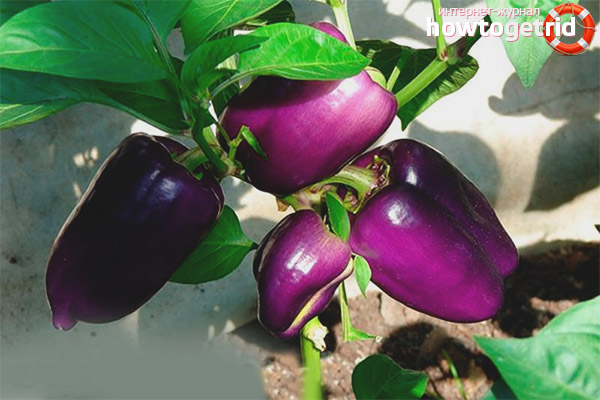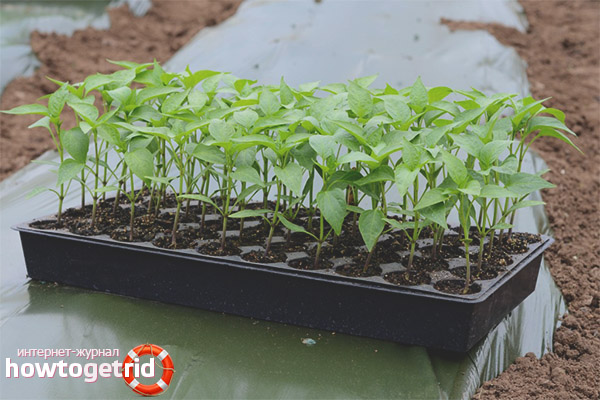The content of the article
Sweet pepper "Big Papa" stands out among other fruits for its bright and unusual color for this vegetable, namely, its rich purple color. Sometimes, however, there are burgundy-colored fruits, which depends on the degree of fruit ripening and storage conditions. This variety is considered to be profitable for planting crops, both for large farms and for home cultivation in household plots.
The main characteristics of the variety
Big Papa belongs to the category of early ripe varieties, the period of full ripening is 100-120 days, depending on climatic conditions. There are a number of signs by which you can determine this type of pepper:
- The variety belongs to the category of undersized, the maximum height of the plant is 50 cm.
- The foliage is large, spreading dark green in color with a purple tint.
- Inflorescences are painted in deep blue.
- The fruits are cone-shaped with thick meaty walls of about 7 mm, the weight of an individual vegetable reaches up to 120 g.
- Color changes from violet to deep burgundy, depending on the ripening period. The inner flesh of the fruit is white.
The yield of the variety is considered quite high and is about 7 kg per 1 sq.m. subject to the basic rules for growing this crop. To understand: 10-14 fruits are formed on one bush.
Recommendations for growing seedlings and care
Adhering to a few simple rules for growing and caring for the plant, you can achieve excellent results in the form of a good harvest of delicious vegetables. Landing Recommendations:
- Big Papa pepper is grown from seeds that are placed in separate pots or in special cassettes, usually made of plastic materials. The best time for planting is considered the beginning of the year, and in particular - January-February.
- In the beginning, the seeds should be grown in seedlings at home, immersed in soil to a depth of 2-3 cm. If the seeds are of proper quality, then the germination rate is at least 85% on average, which is a high indicator of the crop.
- The temperature in the room where the seedlings are located should be maintained within +25 degrees during the day, and not fall below +18 at night.
- This variety belongs to the category of photophilous plants, so you need to follow the regular exposure to sunlight.
- You need to water pepper once a week, this variety is enough for optimal growth. When watering, only warm water at room temperature is used. Watering time falls in the evening - so that the plant is saturated with moisture as much as possible, without unnecessary evaporation, which invariably occurs in sunny time.
Plant care is very important in the early stages - from growing seedlings from correctly selected seeds to choosing the soil and effective top dressing during the period of growth and maturation of the pepper.
Transplanting seedlings and soil requirements
Seedlings are considered fully grown for transplantation after 75 days, after seed germination, by this time the prepared soil should already have been prepared. If the seedlings do not look quite strong, they are treated with a special tool Epin, as they often do for safety during the first experience of growing this variety. Since plants have voluminous foliage, it is recommended to plant bushes at the rate of 5-6 units per 1 sq.m.For different soils, appropriate care is used:
- If the soil for growing pepper has a clay structure, it is better to resort to mineral fertilizers of the plant. In periods of high humidity, in rainy seasons - sand is added to such soil to compact its structure. This prevents the spread of land and exposure of the roots.
- When planting in sandy soil, it is recommended to add fertile black soil or fertilizer with decayed foliage.
- The soil should be loose all the time. This allows you to saturate the roots with oxygen.
- You should carefully monitor the appearance of various weeds that are clogged with seedlings of pepper, taking in nutrients from fertilizer and watering.
- Feeding can be started immediately after the appearance of the first leaves. In the future, it is recommended to fertilize with a break of 2 weeks, it is possible and more often - depending on the chosen fertilizer. Such a system will allow to grow large fleshy fruits.
The optimum ripening period for this variety is 100-105 days from the moment of planting seedlings.
Pest and Disease Control
The Big Papa pepper variety is considered to be a disease-resistant crop, but this does not mean at all that preventive measures against fungal infections that threaten crops threatening the fetus are not necessary. The most common “enemies” of a good harvest are:
- Vertex rot, the main cause of this disease, is a lack of calcium and a large percentage of nitrogen. Most often this happens due to too frequent dressing of the plant, so this should be especially observed when following the recommendations on the dosage of fertilizers. The first signs of infection appear on the fruits themselves, their tips are covered with brown spots. For treatment, high calcium nitrate is recommended.
- The so-called mosaic of peppers is also dangerous for plant growth; it slows down the development and growth of pepper. You can determine by changing the shape of the fetus and the color of the foliage. To prevent the disease, it is necessary to carry out regular soil prophylaxis, seed treatment immediately before planting.
Important! Regular processing of inventory and greenhouse constructions is an important point in the fight against infections and parasites. Suitable for this is a solution of potassium permanganate, which is easy to make at home.
The most dangerous pests of pepper are aphids, ticks and slugs. When insects or their larvae appear, the bushes are sprayed 2 times a week. An effective remedy is a solution with tinctures of garlic and wormwood. The addition of coffee, dry mustard and lime to the soil helps to neutralize slugs, and special traps are also used that can be purchased at garden shops or ordered on the Internet. Planting marigolds in a row with peppers helps a lot. To combat the larvae that completely destroy the roots of the plant, a deep digging of the earth should be carried out before planting, if necessary, manually selecting all the larvae.
Sometimes "false" signs of the disease appear from too abundant watering of the bushes. By reducing the dose of hydration, you can make sure that everything is in order with the plant, and it quickly returns to form.
Suitable climate
This variety of pepper is not capricious to environmental influences, but, knowing which climate is most favorable for good growth and maturation, it will be possible to achieve better results. This variety grows well in the middle zone with moderate climatic conditions.
If planting takes place in more northern regions, then only in the presence of greenhouse structures while maintaining the required temperature. You also need to take care of additional lighting if there is no natural, because pepper is a very photophilous culture, and for the proper growth of the plant, an abundance of sunlight is necessary.
Advantages and disadvantages of the variety

The positive features of this variety include:
- Earlier ripening, which means - there is the possibility of removing a double crop.
- Spectacular purple color. Pepper pleases the eye with a beautiful and unusual color even at the ripening stage, and in the mass it looks very attractive.
- The culture is considered unpretentious in leaving, it is enough to follow a few basic rules to get a good harvest.
- The bushes are neat and low, which means they do not require garter.
- High productivity, 10-12 fruits appear on one bush.
- It adapts well to terrain conditions with proper care.
Among the negative properties of pepper are observed:
- heat intolerance;
- not very large fruits;
- He does not like frequent transplants; he is subject to stresses of soil changes.
The disadvantages of Big Dads are insignificant in comparison with the advantage of this variety, and can be leveled due to the rules for caring for the plant.
Product storage and freezing rules
Big Papa pepper is suitable for preparing various dishes, the most traditional of which are lecho, stuffed peppers, various salads, as well as preservation. Recently, the method of pepper freezing is widely used for use in the winter, when its cost is especially high.
At home, it is recommended to store pepper on a balcony or veranda, insulated for the winter. For storage, wooden boxes are used, in which vegetables are folded, after packing them in paper or plastic bags. Small holes are made for the air flow, so the pepper will not fade. The place must be protected from direct sunlight.
It is necessary to choose completely ripened fruits for freezing - those that have a burgundy color. The pepper does not break, but is carefully cut with a knife, preserving the stem. The fruits are checked for damage and treated with a weak 1% solution of copper sulfate, then wiped with a paper towel. Both individual containers and packages are suitable for freezing. You can freeze pepper whole and cut.
Experts in the planting of sweet pepper agree that the Big Papa variety is a profitable crop and is suitable for both industrial production and home use. Pepper gives an abundant crop of delicious fruits, saturated purple.
Video: Big Dad Peppers











Submit